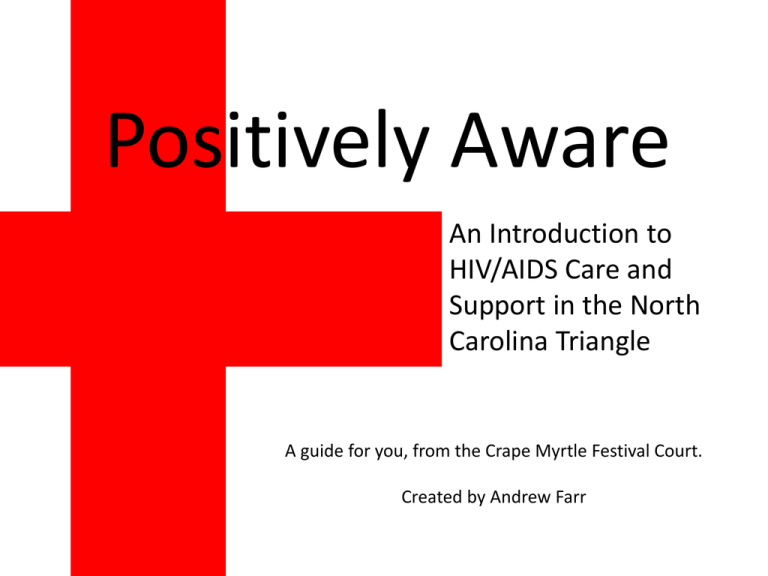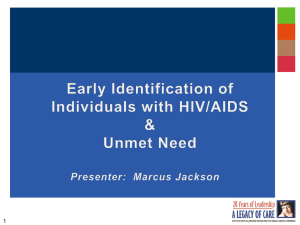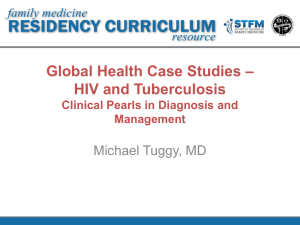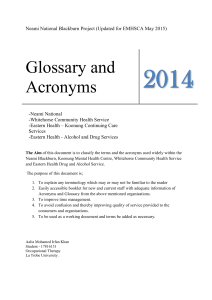Under One Roof - Crape Myrtle Festival
advertisement

Positively Aware An Introduction to HIV/AIDS Care and Support in the North Carolina Triangle A guide for you, from the Crape Myrtle Festival Court. Created by Andrew Farr This presentation covers... • HIV/AIDS service agencies in the NC Triangle • A close up look at Under One Roof, The Alliance of AIDS Services – Carolina and Wake County Human Services • Basics of HIV infection • Major issues facing the HIV+ community Who serves clients? HIV/AIDS care in the NC Triangle consists of many agencies and medical practices. The Alliance of AIDS Services – Carolina What You Need to Know. Downtown Raleigh: Administration, Finance, HR, Prevention, Testing and Counseling, Development Under One Roof: Client Services (Wake and Johnston), Prevention 4 Positives, Faith Ministries, Mental Health Durham: Client Services (Durham and Orange), Prevention 4 Positives, Testing and Counseling, Faith Ministries Hustead House: Housing in Wake County Orange House: Medical Housing in Orange County What is Under One Roof? Under One Roof (UOR) is the social support component of the WCHS HIV/STD Community Outreach Program and HIV Clinic, and the AAS-C’s client services office for Wake and Johnston Counties. UOR has become a national model for collaboration between local government and non-profit as well as a statewide standard of care. Under One Roof 3622 Haworth Dr. 919-571-6600 Under One Roof is a collaborative effort between The Alliance of AIDS Services – Carolina and Wake County Human Services to bring social support services to clients in one location. WCHS: HIV Medical Case Management and Bridge Counseling Services AAS-C: Emergency Financial Assistance, Treatment Adherence, Mental Health Counseling, Substance Abuse Counseling, Prevention With Positives (CRCS), Faith Ministries, Food Pantry, Transportation, Educational and Social Programming Wake County Human Services HIV/STD Community Outreach Program HIV Clinic a WCHS HIV Clinic The WCHS HIV Clinic is located in the Sunnybrook Building at 10 Sunnybrook Rd. UNC Healthcare runs the clinic as a satellite clinic. The collaboration between Wake and UNC allow for cutting edge care through a local health department, which is generally not the case. The HIV Clinic offers primary and specialty care, which is not true of most practices. __________________________________________________________________ Medical Director: Heidi Swygard, MD (UNC ID Clinic) Clinical Director: Robert Dodge, PhD, RN, ANP, AACRN (UNC School of Medicine) WCHS HIV/STD Community Outreach Program Sunnybrook Building and Under One Roof •Prevention Education – Educators are available to come into the community for various events, and they hold their own events. •Testing and Counseling – Testers and Counselors offering services at non-traditional testing sites, prisons, jail, substance abuse facilities and various WCHS locations •Medical Case Management – Medical Case Managers are located at Under One Roof, but are often in the community, and offer long term case management for clients needing to navigate the medical care and social support systems. •Bridge Counseling – Bridge Counselors are also located at Under One Roof and offer short term case management services focusing on access to medical care. The Basics of HIV Infection The Basics of HIV Infection •HIV uses CD4 cells, a type of white blood cells which usually reproduce themselves, to reproduce more virons instead. •This wears out the CD4 cells until it eventually dies. •When these cells die it weakens the human immune system. •The goal of HIV is not to kill these cells, simply to reproduce itself. •Heightened virimia (additional virus in the blood) causes inflammation in the body, leading to other side effects. •Two basic numbers are used to determine the health of a patient: CD4 count and viral load, the amount of each in a mL of blood. •A viral load can be traced down to 20 copies/mL and a CD4 can be determined down to a definite number. The normal CD4 range is between 800-1200 for a healthy human. •200 CD4/mL or less is clinically defined as AIDS, when patients are more susceptible to rare illnesses and opportunistic infections. •Medications are recommended at 500 CD4/mL and less •Medications block the reproduction of HIV at several stages along the life cycle, they do not boost the CD4 count. The body has to rebuild the immune system for itself. The ADAP Crisis • • • • • • • • • Antiretroviral medications cost between $400 and $2500 for a 30 day supply. At least three medications from 2 classes of medications create a cocktail (HAART) Many people have no insurance or are underinsured Taking medications decreases the virus in your blood, making you healthier and decreasing the risk of transmission to others Each state has an AIDS Drug Assistance Program (ADAP), but each state runs their program differently. NC has seen a decrease in funding to ADAP that caused the eligibility to become more strict (from 300% FPL to 125%). This burdens clinics and ASOs by requiring social workers and case managers to seek out other options for acquiring medications. Sometimes that means direct purchase with Ryan White funds ASOs could benefit from funds that support these purchases or increase advocacy to the state legislature The Housing Crunch • Treatment adherence is universally understood to suffer in correlation to the stability of housing. • Housing someone long term is less expensive that dealing with the reprecussions of medical issues associated with non-adherence to HAART • When patients adhere to medications the transmission rates of HIV decrease • WCHS, ACRA and AAS-C provide housing opportunities for HIV+ patients Dental Care • Dental issues are the root cause of many health issues. • When clients cannot eat they cannot absorb medications • Dental issues can lead to serious infections • AAS-C only gets about $12,000 annually to serve about 1,800 clients’ dental needs Thank you from the Crape Myrtle Festival!






